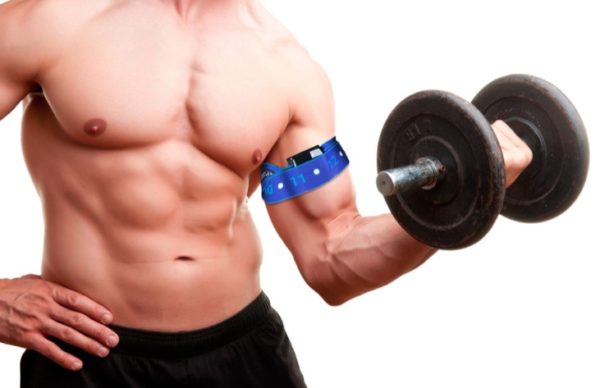Restricted blood flow training? Bro-science or a key to gains?
Nearly everyone in the gym is looking for the best way to get swole. Common knowledge leads us to believe that progressive muscle overload is the key to hypertrophy. Today we look at the science behind restricted blood flow training.
What is restricted blood flow training?
This technique was popularized in Japan and is referred to as KAATSU. Restricted blood flow training has actually been around for around 4 decades. There are a variety of approaches to achieving restricted blood flow but generally, it involves placing a constricting band on your extremities (arm or leg)
Why it’s important to consider restricted blood flow training?
One of the interesting questions is can low intensity exercise with restricted blood flow cause muscle hypertrophy? This is interesting because it goes against the common thought that only progressive muscle load and lifting weights >70% of the one rep max (1RM) can cause hypertrophy. There are multiple ways to incorporate restricted blood flow training into your routine. One is by adding in a low-intensity blood flow restricted day to your workout routine. The other option is for those who are limited and unable to do intense exercise. Those people may get increased strength and hypertrophy while avoiding major load on their muscles, ligaments, tendons since they can work at a lower intensity.
You know I wouldn’t be telling you all of this unless there was some science to back it up!
I’ll admit I was skeptical but after doing some research I found myself a bit more convinced. Multiple studies have found that blood flow resistance training results in increases in both size and strength in the arms and legs. New studies even indicate that both size and strength gains are noticed in muscles that don’t undergo restricted blood flow. One study found size and strength increase in the chest in those who restricted blood flow to the arms but not in a control group that didn’t use RBF. RBF training resulted in increased 1RM on bench press and squat. A meta-analysis (which is a study of that compiles and compares the results of many studies) compared those who didn’t use RBF training to those who did found and found an average difference in muscle size of around half a centimeter. Strength gains were noticed even in those that exercised using around 20% of 1RM. Generally, these types of gains are not noticed until workouts of 45-60% of 1RM in untrained individuals or up to 80-85% in trained individuals. The best results tend to occur and are most easily quantifiable 6 weeks into training. A study in 2000 found that after people who did BFR had significantly increased muscle mass and strength vs those who did high-intensity training at 80% of 1RM
Why in the world does restricted blood flow training give us size and strength gains?
It is hard to tell exactly. One thing we know for sure is that BFR causes an increase in growth hormone, which is pretty profound. Growth hormone is known to increase muscle growth and break down fat. Some studies of RBF have shown a 9 fold increase in growth. Typically GH also causes an increase in IGF-1 which is another growth factor. However, in the case of RBF training IGF-1 does not increase. We also know that RBF does not cause increases in testosterone so we can’t give the credit to our friendly anabolic hormone testosterone. There are other reasons that are less understood but changes in metabolism, byproducts of metabolism, and reactive oxygen species may also play a part. BFR training has been shown to increase muscle glycogen content, which is essentially the fuel cell of our muscles. On a cellular level studies have shown an increase in the synthetic rate of proteins from amino acids. This increase can be as high as 46%. Looking to our genetic code DNA which makes RNA which ultimately makes protein. Restricted blood flow training also initiates the process of making RNA into protein by 3 fold.
Why the hell not start doing restricted blood flow training today?
Some of the biggest concerns involve the risk of cardiovascular issues, blood clots, vascular function, nerve and muscle damage. There have been surveys of 30,000 sessions of RBF exercise training. It is important to remember that those who were surveyed came from a generally healthy population. The most side effects that were reported involved bruising, numbness, and lightheadedness. Some more dangerous side effects such as blood clots were also reported but at a lower rate than that of the general population.
When nerves were studied before and after 4 weeks of BFR training there did not seem to be a change in conduction to indicated nerve damage. However, it has been reported In studies of animals that BFR has resulted in structural tissue damage. The risk of clots remains concerning because of something called Virchow’s triad. Virchow’s triad is made up of three factors which contribute to developing a blood clot 1) abnormal flow of blood 2) injuries to the blood vessel wall and 3) alterations in blood coagulation. We can see how 2 of these conditions may easily be met in blood flow restricted training.
Other studies have looked at the safety of restricted blood flow training by measuring blood markers. Researchers did not find increases in the inflammatory marker (C-reactive protein.) There were also no changes in fibrinogen or D-dimer which are related to blood clots.
So what’s our take away based on the science?
Ultimately restricted blood flow training has some incredibly interesting research behind it. It seems that generally, most studies agree that RBF training can cause increases in both size and strength even when the exercise is performed at low intensity. Some studies have shown size and strength increases in muscles other than those that had restricted blood flow to them (such as the chest.) This is possibly mediated by an increase in growth hormone secretion, but it is not still well understood. We, however, cannot in good conscious recommend doing blood flow restricted training since very little research has been performed to understand the safety of these techniques. It will certainly be interesting to see what future research of these techniques will show.
Going to try restricted blood flow training anyway? Here are a few restricted blood flow training kits on Amazon.
Looking to lose weight, build muscle, gain strength, compete in powerlifting or a bodybuilding show? Check out our custom plans to help you reach your goals!
Don’t want to work 1 on 1 with one of our coaches? Check out our new 8-week workout plan The Beast Beneath! The Beast Beneath is available for immediate download.
Interested in reading more about blood flow restricted training? You can find all the sources below:
Effects of low-intensity bench press training with restricted
arm muscle blood flow on chest muscle hypertrophy: a pilot
study.
Blood Flow Restricted Exercise and Skeletal Muscle Health
Effects of cuff width on arterial occlusion: implications for blood flow restricted exercise
Relative safety of 4 weeks of blood flow-restricted resistance exercise in young, healthy adults
Effect of restricted blood flow on exercise-induced hormone changes in healthy men
Low-intensity blood flow restriction training: a meta-analysis
A Review on the Mechanisms of Blood-Flow Restriction Resistance Training-Induced Muscle Hypertrophy
The efficacy of blood flow restricted exercise: A systematic review & meta-analysis
The Effects of a 7-Week Practical Blood Flow Restriction Program on Well-Trained Collegiate Athletes




